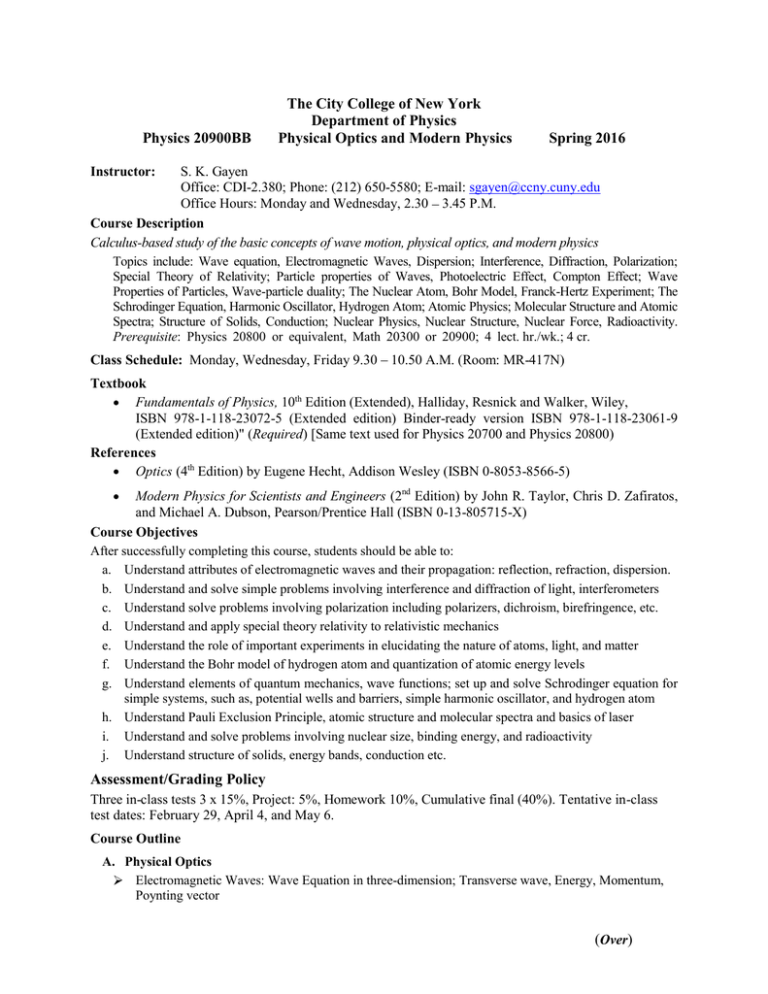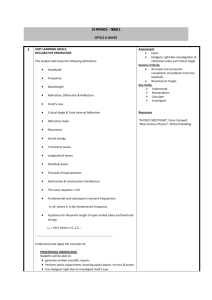
Physics 20900BB
The City College of New York
Department of Physics
Physical Optics and Modern Physics
Spring 2016
Instructor:
S. K. Gayen
Office: CDI-2.380; Phone: (212) 650-5580; E-mail: sgayen@ccny.cuny.edu
Office Hours: Monday and Wednesday, 2.30 3.45 P.M.
Course Description
Calculus-based study of the basic concepts of wave motion, physical optics, and modern physics
Topics include: Wave equation, Electromagnetic Waves, Dispersion; Interference, Diffraction, Polarization;
Special Theory of Relativity; Particle properties of Waves, Photoelectric Effect, Compton Effect; Wave
Properties of Particles, Wave-particle duality; The Nuclear Atom, Bohr Model, Franck-Hertz Experiment; The
Schrodinger Equation, Harmonic Oscillator, Hydrogen Atom; Atomic Physics; Molecular Structure and Atomic
Spectra; Structure of Solids, Conduction; Nuclear Physics, Nuclear Structure, Nuclear Force, Radioactivity.
Prerequisite: Physics 20800 or equivalent, Math 20300 or 20900; 4 lect. hr./wk.; 4 cr.
Class Schedule: Monday, Wednesday, Friday 9.30 10.50 A.M. (Room: MR-417N)
Textbook
Fundamentals of Physics, 10th Edition (Extended), Halliday, Resnick and Walker, Wiley,
ISBN 978-1-118-23072-5 (Extended edition) Binder-ready version ISBN 978-1-118-23061-9
(Extended edition)" (Required) [Same text used for Physics 20700 and Physics 20800)
References
Optics (4th Edition) by Eugene Hecht, Addison Wesley (ISBN 0-8053-8566-5)
Modern Physics for Scientists and Engineers (2nd Edition) by John R. Taylor, Chris D. Zafiratos,
and Michael A. Dubson, Pearson/Prentice Hall (ISBN 0-13-805715-X)
Course Objectives
After successfully completing this course, students should be able to:
a. Understand attributes of electromagnetic waves and their propagation: reflection, refraction, dispersion.
b. Understand and solve simple problems involving interference and diffraction of light, interferometers
c. Understand solve problems involving polarization including polarizers, dichroism, birefringence, etc.
d. Understand and apply special theory relativity to relativistic mechanics
e. Understand the role of important experiments in elucidating the nature of atoms, light, and matter
f. Understand the Bohr model of hydrogen atom and quantization of atomic energy levels
g. Understand elements of quantum mechanics, wave functions; set up and solve Schrodinger equation for
simple systems, such as, potential wells and barriers, simple harmonic oscillator, and hydrogen atom
h. Understand Pauli Exclusion Principle, atomic structure and molecular spectra and basics of laser
i. Understand and solve problems involving nuclear size, binding energy, and radioactivity
j. Understand structure of solids, energy bands, conduction etc.
Assessment/Grading Policy
Three in-class tests 3 x 15%, Project: 5%, Homework 10%, Cumulative final (40%). Tentative in-class
test dates: February 29, April 4, and May 6.
Course Outline
A. Physical Optics
Electromagnetic Waves: Wave Equation in three-dimension; Transverse wave, Energy, Momentum,
Poynting vector
(Over)
Propagation of Electromagnetic waves: Scattering, Reflection, Refraction, Fresnel Equations,
Dispersion
Polarization: Linear, Circular, Elliptical, Representation as superposition of two orthogonal
components; Dichroism, Birefringence, Retarders
Interference: Review of
-Slit Experiment, Coherence, Thin-Film interference,
Interferometers (Michelson and Fabry-Perot)
Diffraction: Fraunhofer Diffraction, Review of Single-slit and double-slit experiments; Multiple-slit
diffraction, Intensity distribution; Diffraction grating
B. Modern Physics
Special Theory of Relativity, Lorentz Transformation, Relativistic Mechanics, Energy and Momentum
Particle Properties of Waves, Photoelectric Effect, Compton Effect
Wave Properties of Particles, de Broglie Waves, Wave-Particle Duality
The Nuclear Atom, Bohr Model, Franck-Hertz Experiment
The Schrodinger Equation, Potential Well, Potential Barrier
Quantum Theory of Harmonic Oscillator and Hydrogen Atom
Atomic Physics, Many Electron Atoms, Pauli Principle, Periodic Table; Lasers
Molecular Structure and Spectra
Structure of Solids, Conduction
Nuclear Physics: Nuclear Structure, Nuclear Force, Radioactivity
Elements of Particle Physics
General Information
Academic Integrity and Plagiarism: The CCNY Policy on Academic Integrity will be strictly adhered to. The
UNY Policy on Academic Integrity is available from the link
Policy and
document entitled,
University Information o Information for Current Student of the CCNY Home Page. Make sure you have
read the details regarding plagiarism and cheating, and be clear about the rules that the college follows. Cases
where academic integrity is compromised will be prosecuted to the fullest extent according to these rules.
Attendance: Class sessions will focus on discussion of concepts, derivation of key formulae, as well as, problem
solving. Regular attendance, on-time arrival, and participation in entire class sessions are required. Absence in a
test without prior permission, or unavoidable circumstances (such as, sickness, emergency, etc.) will result in a
score o
for the test.
Homework: Solving the homework problems is the key to success in the course. The problems in the tests will
relate to the concepts covered in the homework problems and in the worked out problems in the class and in the
textbook. Homework assignments will be collected, graded, and returned to the students.
Study Tips: To derive maximum benefit from lectures, please skim through the material that will be taught. To
be up to date, please go through the lecture notes, textbook, and rewrite your lecture notes before the next class.
To develop comprehension of the materials and to be able to use those, solve the homework problems, and
engage your classmates and instructor in discussions. While individual efforts may vary, on the average expect
to spend 5-10 hours per week, every week, studying and solving problems, in addition to the time spent in lecture.
Accommodations for students with disabilities: Qualified students with disabilities will be provided
reasonable academic accommodations if determined eligible by the Access Ability Center (AAC). Prior to
granting disability accommodations in this course, the instructor must receive written verification of a student s
eligibility from the AAC, which is located in NAC 1/218. It is the student s responsibility to initiate contact
with the AAC and to follow the established procedures for having the accommodation notice sent to the
instructor.
(Over)



